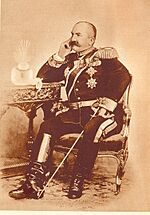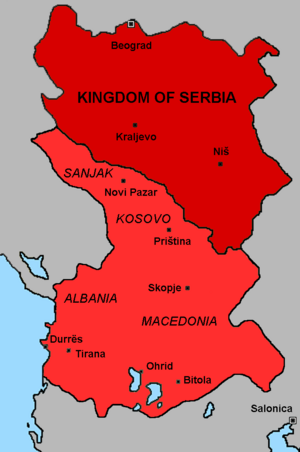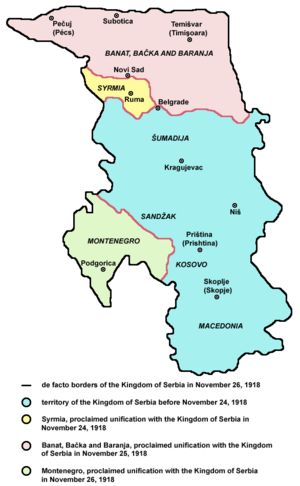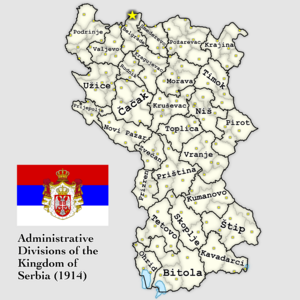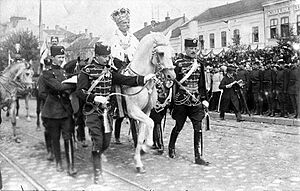Kingdom of Serbia facts for kids
Quick facts for kids
Kingdom of Serbia
Краљевина Србија
Kraljevina Srbija |
|||||||||||||||
|---|---|---|---|---|---|---|---|---|---|---|---|---|---|---|---|
| 1882–1918 | |||||||||||||||

The Kingdom of Serbia in 1914
|
|||||||||||||||
| Capital and largest city
|
Belgrade 44°48′35″N 20°27′47″E |
||||||||||||||
| Common languages | Serbian | ||||||||||||||
| Religion | Eastern Orthodoxy (state religion) | ||||||||||||||
| Demonym(s) | Serbian, Serb | ||||||||||||||
| Government | Unitary parliamentary constitutional monarchy | ||||||||||||||
| King | |||||||||||||||
|
• 1882–1889
|
Milan I | ||||||||||||||
|
• 1889–1903
|
Alexander I | ||||||||||||||
|
• 1903–1918
|
Peter I | ||||||||||||||
| Prime Minister | |||||||||||||||
|
• 1882–1883 (first)
|
Milan Piroćanac | ||||||||||||||
|
• 1912–1918 (last)
|
Nikola Pašić | ||||||||||||||
| Legislature | National Assembly | ||||||||||||||
| Historical era | |||||||||||||||
| 6 March 1882 | |||||||||||||||
|
• May Coup
|
10 June 1903 | ||||||||||||||
| 30 May 1913 | |||||||||||||||
|
• Treaty of Bucharest
|
10 August 1913 | ||||||||||||||
|
• Corfu Declaration
|
20 July 1917 | ||||||||||||||
|
• Podgorica Assembly
|
28 November 1918 | ||||||||||||||
|
• Creation of Yugoslavia
|
21 December 1918 | ||||||||||||||
| Currency | Serbian dinar | ||||||||||||||
| ISO 3166 code | RS | ||||||||||||||
|
|||||||||||||||
| Today part of | |||||||||||||||
|
|||||||||||||||
The Kingdom of Serbia (Serbian: Краљевина Србија, Kraljevina Srbija) was a country in the Balkans. It was formed in 1882 when Milan I, who ruled the Principality of Serbia, became king.
Before becoming a kingdom, Serbia was a principality. It was mostly ruled by the Obrenović dynasty. The principality gained full independence in 1867 when the last Ottoman troops left Belgrade. In 1878, the Congress of Berlin officially recognized Serbia's independence. It also added new areas to Serbia, including Nišava, Pirot, Toplica, and Vranje.
From 1912 to 1913, Serbia grew much larger. This happened after the First and Second Balkan Wars. New regions like Sandžak-Raška, Kosovo Vilayet, and Vardar Macedonia joined Serbia. After World War I in 1918, Serbia joined with Vojvodina and the Kingdom of Montenegro. In December 1918, it merged with the new State of Slovenes, Croats and Serbs. Together, they formed the Kingdom of Serbs, Croats and Slovenes. This country later became known as Kingdom of Yugoslavia. The Karađorđević dynasty continued to rule this new kingdom.
Contents
History of the Kingdom of Serbia
From Principality to Kingdom
The Principality of Serbia was a state in the Balkans. It was created after the Serbian revolution, which took place between 1804 and 1817. Leaders like Karađorđe and Miloš Obrenović helped free Serbia from centuries of Ottoman rule.
At first, the principality was small. But from 1831 to 1833, it expanded to the east, south, and west. Most of the people living there were Serbs. Over time, the population changed, with some groups moving out and others arriving.
In 1867, the Ottoman army left the principality. This made Serbia truly independent. Serbia gained more land in the southeast in 1878. This was when its full independence was recognized at the Congress of Berlin. After this expansion, some people moved from these new areas, mainly to Kosovo. This marked the start of the Serbian-Albanian conflict.
Serbo-Bulgarian War (1885)
The Serbo-Bulgarian War began on November 14, 1885. It lasted until November 28 of the same year. Serbia lost this war. It failed to capture the Slivnitsa region, which was its goal. Bulgarian forces won a key battle at Battle of Slivnitsa and then moved into Serbian territory. They took Pirot and opened the way to Niš.
When Austria-Hungary said it would join the war to help Serbia, Bulgaria pulled its troops out of Serbia. The border between Serbia and Bulgaria stayed the same as before the war. A peace treaty was signed in Bucharest on February 19, 1886. Because of this war, European countries accepted that Bulgaria had united on September 6, 1885.
Balkan Wars and Serbia's Growth
Serbia, Russia, and Bulgaria made an agreement in March 1912. They planned to take over and divide the Ottoman-controlled region of Macedonia. In May, Serbia and Greece formed an alliance. In October 1912, Serbia and Montenegro also signed an alliance.
After the war started, Serbia and Montenegro captured Pristina and Novi Pazar. Serbian forces defeated the Ottoman army at the Battle of Kumanovo. They then took Skopje and the entire Kosovo vilayet region. Montenegro took the Metohija region. Serbian and Greek armies met at Bitola and Ohrid.
The people living in Kosovo were a mix of different ethnic groups. So, the new Serbian rule was seen differently by locals. Serbs saw it as a liberation. In November 1913, Serbia created the Drač County in Albania. This area was taken from the Ottoman Empire during the First Balkan War.
After the First Balkan War in 1912, Kosovo and northwestern Macedonia became part of Serbia. Northern Metohija became part of Montenegro. This was officially recognized by the Treaty of London in May 1913.
Disagreements about the Macedonia region led to the Second Balkan War. In 1913, Serbia, Greece, Romania, the Ottoman Empire, and Montenegro fought against Bulgaria.
The final borders were set by the Treaty of Bucharest in 1913. Serbia gained control of the land known as Vardar Macedonia. This area is now the independent country of North Macedonia. However, Serbia could not reach the Adriatic Sea because the new Principality of Albania was created.
As a result of these wars, Serbia's population grew from 2.9 million to 4.5 million. Its territory also increased by 81%.
The Assassination in Sarajevo
On June 28, 1914, Archduke Franz Ferdinand of Austria was killed in Sarajevo. At that time, Sarajevo was part of Austria-Hungary. This event greatly increased the tension between Austria-Hungary and Serbia.
A secret Serbian officers' group called the Black Hand was behind the assassination. The people who carried out the assassination received help from a network of Serbian civilians and military officers. This network provided transport, hid them, and gave them training, weapons, maps, and information. After the assassination, the people involved were arrested in Bosnia-Herzegovina. They were put on trial in Sarajevo in October 1914.
The main goal of the assassination was to separate the southern Slav provinces from the Austro-Hungarian Empire. This event started a series of international events. These events eventually led to Russia and other major European powers joining the conflict.
Serbia in World War I
On July 28, 1914, Austria-Hungary declared war on Serbia.
In 1915, Serbia was taken over by foreign armies. Troops from Austro-Hungary, Germany, and Bulgaria invaded together. The Serbian Army, with 135,000 soldiers, retreated through Albania. They were then taken to the Greek island of Corfu. In the spring of 1916, they became part of a new battle line called the Salonika front. In 1916, the Kingdom of Montenegro was conquered by Austria-Hungary.
By the end of the war, Austria-Hungary collapsed. Serbia had lost 28 percent of its people from before the war. After being freed, Serbia went through big changes very quickly. On November 28, 1918, it joined with the Kingdom of Montenegro at the Podgorica Assembly.
On December 1, 1918, Serbia united with the new State of Slovenes, Croats, and Serbs. They formed a new South Slav country, the Kingdom of Serbs, Croats and Slovenes. This new country continued to be ruled by the Serbian monarchy. In August 1921, Prince Alexandar I became its king.
Politics and Government
In 1888, the People's Radical Party, led by Sava Grujić and Nikola Pašić, came to power. A new constitution was introduced. It was based on the liberal Constitution of Belgium. King Milan I gave up his throne in 1889. This happened partly because Serbia lost a war and the Radical Party won all the elections. His son, Alexander I, became king in 1893. In 1894, he removed the new constitution.
Jewish people from what is now North Macedonia gained citizen rights after their region became part of the Kingdom of Serbia.
The May Coup of 1903
King Alexander I of Serbia and his wife Queen Draga died during an event at the Royal Palace in Belgrade on the night of May 28–29, 1903. Other members of the Obrenović family also died. This event ended the rule of the House of Obrenović, which had governed Serbia since 1817.
After this event, the Serbian Skupština invited Peter Karađorđević to become king. He became Peter I of Serbia. A constitutional monarchy was then set up. The military society Black Hand had influence behind the scenes. Serbia's good relations with Austria-Hungary ended. The new royal family relied on support from the Russian Empire and worked more closely with the Kingdom of Bulgaria.
The Pig War (1906–1909)
In April 1904, Serbia signed a friendship treaty with Bulgaria. In June 1905, they signed a customs union. In response, Austria-Hungary started a trade war against Serbia. This was known as the "Pig War" and lasted from 1906 to 1909. After the 1906 elections, the People's Radical Party returned to power. In 1908, Austria-Hungary took over Bosnia. Serbia had hoped to expand its own territory there.
The Bosnian Crisis (1908–1909)
The Bosnian Crisis happened in 1908–1909. It started when the Kingdom of Bulgaria declared full independence from the Ottoman Empire on October 5, 1908. The next day, October 6, 1908, Austria-Hungary announced it was taking over Bosnia and Herzegovina. Most people in Bosnia were South Slavs.
Austria-Hungary wanted to expand its empire. It saw the Balkans like other powerful countries saw Africa or Asia. Serbian people and thinkers strongly disagreed with this idea.
Many countries were interested in these events. These included Russia, the Ottoman Empire, Britain, the Kingdom of Italy, Serbia, the Principality of Montenegro, Germany, and France. In April 1909, the 1878 Treaty of Berlin was changed to accept the new situation. This ended the crisis. However, the crisis permanently damaged relations between Austria-Hungary and Russia and Serbia. The takeover of Bosnia and the reactions to it were some of the reasons that led to World War I.
How Serbia Was Divided
In 1890, the Kingdom of Serbia was divided into 15 districts, called okruzi. These districts were then split into smaller areas called srezovi (counties). The cities of Belgrade and Niš had special administrative rules. The districts included: Valjevo, Vranje, Kragujevac, Krajina, Kruševac, Morava, Pirot, Podrinje, Podunavlje, Požarevac, Rudnik, Timok, Toplica, Užice, and Crna Reka.
In 1912 and 1913, Serbia gained more land after winning the First Balkan War. In August 1913, 11 new districts were created in these newly freed areas. These were: Bitola, Debar, Kavadarci, Novi Pazar, Kumanovo, Pljevlja, Prizren, Priština, Skopje, Tetovo, and Štip.
Kings of Serbia
During its time, the Kingdom of Serbia was ruled by two main royal families: the House of Obrenović and the House of Karađorđević.
King Milan Obrenović ruled from March 6, 1882, to March 6, 1889. He then gave up his throne. His son, Aleksandar Obrenović, became king and ruled from March 6, 1889, until June 11, 1903. King Alexander and his wife Queen Draga died during an event involving a group of officers. This event ended the Obrenović family's rule.
This opened the way for the descendants of Karađorđe (Karageorge) to return to the throne. Karađorđe was seen by Serbs as the person who helped free them from Ottoman rule. Petar Karađorđević was not eager to become king at first. He was upset by the way the previous king died. However, he eventually accepted the crown. He was the king from June 15, 1903, until December 1, 1918. On that day, the Kingdom of Serbs, Croats and Slovenes was announced.
Major Cities and Population
Largest Cities in the Kingdom
The biggest cities in the Kingdom of Serbia around 1910–1912 included:
|
Largest cities or towns in Kingdom of Serbia
https://pod2.stat.gov.rs/ObjavljenePublikacije/G1953/pdf/G19534002.pdf |
||
|---|---|---|
| Rank | Pop. | |
| 1 | Belgrade | 100,000 |
| 2 | Prizren | 60,000 |
| 3 | Bitolj | 54,000 |
| 4 | Skoplje | 50,000 |
| 5 | Niš | 25,000 |
| 6 | Veles | 24,000 |
| 7 | Priština | 20,000 |
| 8 | Prilep | 20,000 |
| 9 | Kragujevac | 18,500 |
| 10 | Ohrid | 18,000 |
Economy and Transport
Improving Transportation
Serbia was located on important trade routes. These routes connected Western and Central Europe with the Middle East. The Morava Valley was a key land route linking Central Europe to Greece and Constantinople. In the 1800s, many efforts were made to improve transport along these routes.
At the Congress of Berlin in 1878, Austria-Hungary helped Serbia gain new lands. But Serbia had to agree to build a railway line from Belgrade to Vranje and to the Turkish and Bulgarian borders within three years. Serbia also had to sign trade agreements and work on improving the Đerdap area. The Serbian Government approved this treaty. As a result, Serbian Railways were created in 1881. Regular train service on the Belgrade–Niš railway line began in 1884.
Culture
Art and Exhibitions
The Kingdom of Serbia took part in the International Exhibition of Art of 1911. Several Serbian artists showed their work there. These included Marko Murat, Ivan Meštrović, and Đorđe Jovanović.
See also
- History of Serbia
- Invasion of Serbia by Bulgaria during the First World War




